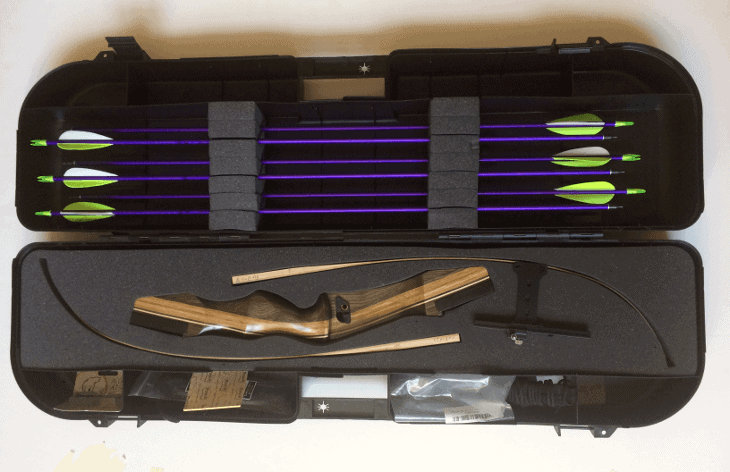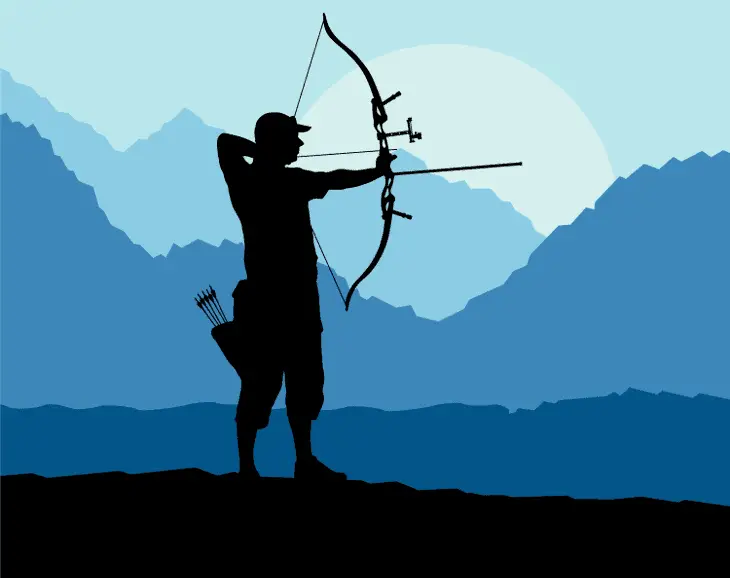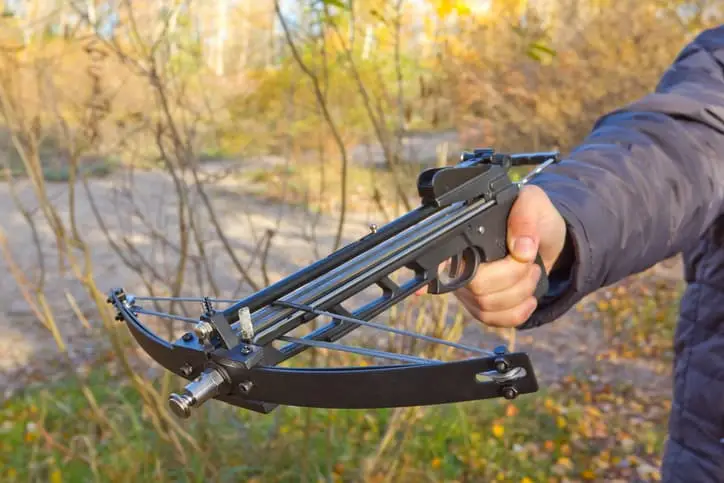Note: Our site links to archery and bowhunting products sold by outside vendors, and we may earn a small commission if you purchase an item after clicking one of these links. Learn more about our affiliate program.
If you’ve strolled around our site, you may have noticed: we’re big fans of the Samick Sage Recurve Bow. We think it’s a fantastic bow for new archers, and it seems like we praise it at every opportunity. It’s fairly accessible, simple to put it together, and reasonably easy to use, and that makes it a great bow for beginners.
- READY TO SHOOT – Includes: Riser – 2 Fiberglass laminated limbs (Choose from 25 lbs – 60 lbs draw) – 14 dacron bowstring – arrow rest – 6 arrows – 2 brass nocks – stringer tool – arm guard – finger guard – quiver.
- ERGONOMICALLY DESIGNED – Samick’s risers are manufactured with imported Maple wood, for lightweight and highly durable bows, with a comfortable ergonomic grip.
- FEATURES – Pre-installed threaded Brass Bushings for various attachments and upgrades, such as, Brass Plunger, Stabilizer, Sight, Quiver, Bow fishing reel.
That said, we’ve never really given it a closer look, and provided a proper Samick Sage review.
To fix that, we’ll get into the nitty-gritty in the post below: what’s good about the Samick Sage, the few things that are so-so, and accessories you may want to consider if you want to dress it up a little bit.
We’ll start with a general measurement:
Samick Sage Specs: Respectable
Before we jump into what we like and dislike, here are the general specs for the Samick Sage. We’ll talk more about each of these factors in the sections below.

Orientation: Left-handed and right-handed models are available, which is fantastic; very often, a manufacturer will only make right-handed bows, and that’s a bummer, so it’s nice that the Samick Sage is available for lefties, as well.
Length: 62 inches; about right for a bow of this caliber. A little long for hunting, but we think this isn’t the best bow for hunting (and we’ll talk about that in a minute).
Draw Weights: Range all the way from 25 pounds (aka, 25# in archery talk) to 60 pounds, in five-pound increments: 25 / 30 / 35 / 40 / 45 / 50 / 55 / 60.
Unit Weight: Roughly 3.5 pounds, give or take; we actually had a hard time finding the exact weight. That weight—3.5 pounds—is pretty reasonable for a bow of this stature.
Riser Material: Oak, Hard Maple and Dymondwood (laminate). The riser is actually very handsome, in our humble opinion!
Brace Height: 7.5 inches to 8.25 inches (recommended). More about brace height in the video below.
Draw Length: 29 inches, maximum. Most archers fall in the draw length range of 29 inches and below, and this bow is designed as a good option for most archers.
OK! Those are the “broad strokes.” Now let’s look at the important features of the bow a little more closely. We’ll start with our favorite aspect of this bow:
It’s a Takedown Bow, and That’s a Huge Plus
We’ll start at the beginning, and if you’ve been in the archery game for a while, feel free to skip this section (although we do think this is an important part of our Samick Sage review): a takedown bow is one that allows you to remove the limbs from the riser (aka, the handle of the bow). Old-school bows were one piece of wood and the limbs where permanently attached to the riser, but a lot of new bows are takedown models, which means you can “take down” the limbs and remove them when you want to.
That sounds like a chore, right? Having to take off the limbs every time you want to use the bow?
Well, believe it or not, it’s actually a HUGE advantage, because a takedown bow allows you to change the strength of the bow. Here’s how that works:
The draw weight of a bow measures how much potential energy the bow can store when it’s drawn, and a bow with a lower draw weight (say, 30 pounds) will store less potential energy and shoot with less force than a bow with a higher draw weight (say, 50 pounds). The higher the draw weight, the stronger the bow, and the faster it shoots.
So, with a takedown bow, because you can remove the limbs, you can start off with a lower draw weight, and when you’re ready, remove the limbs and replace them with stronger ones—making the bow more powerful.
And that is, perhaps, one of the biggest advantages of the Samick Sage, and why we think it’s a great choice for beginners: you can change the draw weight of the bow by removing the limbs and replacing them. When you’re a beginner and you need to shoot a lower weight, you screw in 30-pound limbs to the bow.
After you’ve been shooting for a while and you’ve gained some strength, you can buy stronger limbs—say, 35-pound limbs—and use those. Then, when you’re ready for 40-pound limbs, you can get and use those, and so on and so forth. It’s kind of like getting a new bow, because it will shoot faster and with more force.
And that’s why the Samick Sage is such a great bow for beginners: because the bow can “grow” with you. As you gain skill and need a stronger bow with a heavier draw weight, you can replace the limbs you currently have with stronger ones.
It’s Easy to Assemble: Another Huge Plus
This is, in our minds, the other big reason that makes the Samick Sage a great choice for beginners: it’s easy to put together.
When you’re new to archery, it’s easy to get overwhelmed: archery is a pretty technical sport, and there seem to be endless terms, measurements, and pieces of equipment. It can be overwhelming, and it can make it tough to start out.
And that’s why it’s great to start on a recurve—they’re a lot simpler than compound bows—and that’s why the Samick is a good intro model: you screw in the limbs, twist the string to adjust the brace height, attach the arrow rest, set the nock, and you’re good to go!
“But wait!” you may be saying. “I don’t know what the brace height is! I don’t know how to attach the arrow rest!”
Luckily, the Samick Sage is a popular beginner bow, so there are a ton of videos online that show how to set it up. Far and away, our favorite is this one, from Lancaster Archery:
And that’s it! Follow those instructions, and you have your own recurve bow, ready to shoot. Trust us on this one: the further you get into archery, the harder it gets, and having a bow that you can set up so easily—it’s a really wonderful thing, in our humble opinion, and we thought it was important enough to mention in our Samick Sage review.
It’s Easy to Add Accessories to the Riser
This is another aspect of the bow that makes it great for beginners: there are multiple locations on the riser where you can install a bow sight, an arrow rest, a bow stabilizer, etc. You can dress it up in a number of different ways in order to try and increase performance, and that, too, is a way to increase your understanding of how bows work.
There are literally dozens of different add-ons you can buy, but some accessories that work well with the Samick Sage include:
A Bow Sight.
- ✅High Impact Nylon Construction: Light weight and durable for archery target shooters
- ✅Smooth Micro Windage Adjustment Includes Ring Pin With Dot
- ✅Extention Length: 6″; Weight: 4.5 oz
We think the Adjustable Target Bow Sight is a good option for beginners using a Samick Sage—simply use a hex key to screw the sight into the side of your riser, and then “sight in” to try and increase your aim. “Sighting in” is basically adjusting your sight so that when you aim, you’re aiming at the bullseye, and it can take a while, but here’s a tip that’ll save you a lot of time: chase your arrows.
If you notice your arrows are all grouping above the bullseye, “chase the arrows” and move your sight upwards. If you notice your arrows are all grouping below the bullseye, “chase the arrows” and move your sight downwards. Keep doing that until you’re “sighted in” and your arrows are grouping closer and closer to the bullseye.
Bow sights aren’t a sure thing, and they’re not going to make you into Robin Hood, but they’re designed to help you hit your targets, and with time and practice they can help you develop your aim.
An Arrow Rest.
- Designed To Help You Get The Most Out Of Bear Weathers, Feathers And Vanes
- Self-Adhesive Back And Finger To Hold Arrows
- Model Number: 2135
Most new archers choose to shoot off an arrow rest—it’s a little easier than not installing one, and “shooting off the shelf”—and the Bear Weather Arrow Rest is relatively easy to install and use on the Samick Sage. The guy in the video above shows how to install one of these—basically, you remove the label and stick it to the bow using the adhesive. For a little plastic thing, it’s surprisingly sturdy.
We realize that if you’re reading this review, you may be new to archery, so you may find the following pieces of equipment helpful. Sometimes it’s difficult to know all the pieces you’ll need to get started, and with that in mind…
There are two pieces of equipment designed for your safety you may want to consider:
An Arm Guard.
- Crafted from Suede, arm guard features a two- strap, Velcro design to ensure a comfortable-fit, but snug fit
- Vented to provide proper air-flow
- Arm guard is 7 Inch in length
Believe it or not, the most common injury related to archery is inner-arm bruising that can happen when you’re not wearing protective gear. A bruise doesn’t sound like much, but they can be really painful, and most ranges require you to wear protective gear when you’re shooting. The OMP Mountain Man can be a good choice—it’s 7 inches (long enough to cover the entire forearm) and it’s made from a stiff suede.
Shooting Gloves.
- Model Number: DWC
- Item Package Length: 5.799999994084″
- Item Package Width: 5.49999999439″
This is another piece of equipment that you may see archers using. The material is usually leather or something like it, and it protects your fingers from the bowstring. We’ve had good luck with the Damascus Shooting Glove.
And, finally, there are two pieces of “transportation” equipment that you may find helpful:
A Carrying Case.
- DESIGN: Built for takedown recurve bows, Holds max of 18 arrows up to 34″ in length; Built in broadhead wrench. Overall case length 37″
- PROTECTION: Weather resistant hard case lockable snap closures
- NO BOW OR ARROWS INCLUDED WITH PURCHASE
There are two reasons a bow case can be useful: 1) they protect your bow as you move it from place to place, and 2) they protect other people from your bow as you move it from place to place! We’ve used the Vista Travel Takedown Case, because the Samick Sage, when taken apart, fits inside it perfectly, and there’s also room for six to twelve arrows and various pieces of gear (like a hex key, shooting gloves, bow sights, etc.). Here’s a photo, with the Samick Sage dissassembled and tucked away inside:

And, lastly…
A Quiver.
- Reversible hook and loop pocket for ambidextrous Use
- Integrated accessory attachment grommet, belt Clip attachment and Bow square slot
- Three tube design to keep arrows organized
Easton has been in the archery game for a long time, and their Flipside 3-Tube Hip Quiver can be a good option for beginners and advanced shooters alike. It’s adjustable, so rights and lefties can use it, it’s got a small pouch for odds-and-ends you may want to store, and it can hold between six arrows (with space for each arrow) and 12 arrows (if you want to cramp them together a bit).
We’ve actually written an entire post about the accessories you can get for a Samick Sage, so check that out if you want to read more.
There are Some Disadvantages to the Samick Sage, However…
As we’ve said, we’re big fans of the Samick Sage, but it’s NOT perfect. It does have some negatives, most notably:
The String is… Not Great, and That’s Being Generous. The string that comes with the bow is “meh” at best, and you may want to replace it as soon as you can. The string on our first Samick last about two months before it became frayed and looked like it was going to snap in half, even though we waxed it and went pretty easy on it. A string that’s going to snap in half is obviously pretty dangerous, so keep an eye on that string as you use it. If it frays, you’ll want to replace it ASAP.
It’s Got a Limited Draw Length. We mentioned above that the Samick has a draw length that’s good for most average-height archers. If you’re on the tall side, though—5’ 11” and up—and have a very long draw length of 29 inches or more, the Samick Sage might not be a good fit for you. If you’ve got a longer draw length, we usually recommend the Spyder XL Takedown Recurve, which is a similar bow in both quality and strength, and designed for folks who have a draw length of 29 inches and longer.
No products found.
It’s Should Only Be Used for Hunting by VERY Skilled Archers. The Samick is a great bow for developing your archery skills, but if you’re still developing your archery skills… well, you shouldn’t be bowhunting! If you’re not a skilled archer, you may end up wounding game instead of killing it, and that’s unethical (at best—it’s cruel, really). If you are a skilled archer, you can hunt with the Samick—it’s definitely accurate enough, when shot by someone who knows what they’re doing—and you’d have to look up your state regulations to see how heavy you’d need the bow to be (most states require you to hunt with a bow that’s 40 pounds or higher for smaller game, and more than that for larger game). If you’re new to archery, though, we’d urge to make sure you can reliably hit your targets before you go hunting.
It’s a Great Beginner Bow, but It’s Not a Great Bow for Black Belt Expert Olympians. Here’s what we mean by that: while the Samick Sage has a number of great features that makes it a very solid bet for beginners, there are better bows out there, and if you’ve made a commitment to archery, and are obtaining higher and higher quality bows, the Samick Sage is probably not for you.
It’s doubtful you’re going to see an Olympian using a Samick Sage in the Summer Games. If you’re new to archery, it’s a great choice. If you’re a skilled, experienced archer, and are used to extremely high-end bows made with ultra-precise specifications, the Samick Sage is probably not for you.
The Most Important Question: How Does It Shoot?
Perhaps we should have mentioned this sooner. These are all our humble opinions, but… it shoots pretty darn well!
The riser is ergonomically designed, so it’s satisfying to hold; with a decent sight, it’s easy to aim; and with proper tuning, it’s pretty quiet. It’s a recurve, so the draw weight is consistent throughout the entire shot, but the shelf is cut past center, and it’s easy to determine (and find and find again) an anchor point from which to draw.
All in all, it shoots very well, and—having shot a lot of rental bows at a lot of ranges—it feels smooth and well-made.
That Seems Like a Good Place to End
There a lot of bows on the market, and getting started in archery can be a little overwhelming. We think the Samick Sage is a great place to start: it’s easy to assemble, easy to use, and very well made. If you’re a beginner and new to archery, we think it’s a great bow to get started on. With proper tuning, it can allow you to develop your skills and learn about archery. Outside of a few negatives—the biggest of which is that bow string—we think it’s a solid bet. If the price is an issue check out our review of the Keshes takedown recurve bow, its made by the same company at a lower price point.
Sale
- READY TO SHOOT – Includes: Riser – 2 Fiberglass laminated limbs (Choose from 25 lbs – 60 lbs draw) – 14 dacron bowstring – arrow rest – 6 arrows – 2 brass nocks – stringer tool – arm guard – finger guard – quiver.
- ERGONOMICALLY DESIGNED – Samick’s risers are manufactured with imported Maple wood, for lightweight and highly durable bows, with a comfortable ergonomic grip.
- FEATURES – Pre-installed threaded Brass Bushings for various attachments and upgrades, such as, Brass Plunger, Stabilizer, Sight, Quiver, Bow fishing reel.











